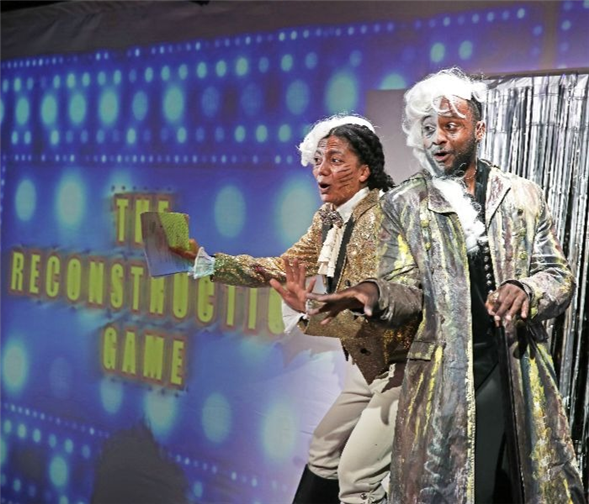Translate Page

The immersive Black History Museum takes a satirical look at 400 years of the African-American experience
---
Regardless of how you identify, The Black History Museum…According to the United States of America at HERE Arts Center will probably make you uncomfortable. An immersive theatrical experience, the show/exhibition takes audiences on a satirical yet harrowing journey through slavery, Jim Crow and contemporary oppression. It's an endurance test in many ways, including physically since you're on your feet participating for two jam-packed hours.
There's no sitting on the sidelines: Your ticket is a "black card" that grants every attendee the same treatment. It begins with a recreation of the voyage through the Middle Passage, as the audience is corralled into a small wooden structure. Four dancers are kidnapped and enslaved as you bear witness to their struggle. It only gets more intense from there, with a range of interactive activities including a slave auction, a game show about Reconstruction and a call-and-response rally. "It's hard because Americans are not used to satire," says creator-director Zoey Martinson about her production, which challenges the popular (i.e. white privileged) understanding of black history. "We're all really sensitive to a lot of these things -- especially now."
Martinson, who earned an MFA in acting at NYU Tisch, has an eclectic background as an artist and activist. She started down this path a decade ago as a humanitarian aid worker at a Liberian refugee camp in Ghana, where she helped to rehabilitate child soldiers. Since then she's written politically minded plays that toured internationally; spearheaded an arts mission for the U.S. Consul General to South Africa, where she created original work with adults and children; and racked up Off-Broadway and TV acting credits, and impressive fellowships at Manhattan Theatre Club and Lincoln Center.
Martinson had been pitching her concept for The Black History Museum to various theatres for a few years without success. But once she was accepted to the HERE Arts Residency Program, which comes with $50,000 in cash, $50,000 in space and other long-term support, she and her company Smoke & Mirrors Collaborative were able to take a deep dive into our country's complicated history.
The show began to take shape when Martinson and her collaborators participated in a creative workshop in New Orleans. Realizing that the city contained a treasure trove of well-preserved records on slavery, the team conducted extensive research at institutions such as the Amistad Research Center and the Museum of Free People of Color. Wary of adding to the glut of dispiriting slave epics, Ari Fulton the show's costume designer suggested they focus on love stories. Reading love letters between slaves at Whitney Plantation inspired a turning point in tone. "I think if we hadn't been there, we would have kept going into the trauma of slavery," says Martinson. "But we were done with that narrative, so we went toward the opposite."
{Image1}
Martinson was born to an Ethiopian father and a Norwegian-Native American mother. Growing up, she always felt secure in her multicultural and multiracial identity until she was introduced to slavery in fourth grade. "I remember feeling ashamed of my skin color because I hadn't learned about how we overcame oppression and how there was love there," Martinson says. "I didn't know that we were survivors who built this country without receiving any credit."
Martinson says with some of her past work, she encountered censorship and criticism that she was "going too far" from white collaborators and producers. So she purposefully developed The Black History Museum with an all-black creative team. "If we feel there is something we want to explore or present, we've given each other permission to do that," she says. "When you're in a group of people of color, you're just a human. Color kind of gets removed from the equation so you're just speaking to each other as people."
While The Black History Museum chronicles documented if underacknowledged ways the U.S. government has perpetuated white supremacy for centuries (sabotaging the Freedman's Savings Bank, the creation of the Black Codes, implementing our modern-day incarceration system), it's also fueled by the real-life experiences of its artists. With input from writer Jonathan Braylock, Martinson transformed testimony about her brother's experience with prison into a satirical sketch featuring Presidents Nixon, Reagan, Bush, Clinton and Bush Jr. arguing over whose policies most oppressed the African-American community.
With more than 400 years of history to navigate, there is a lot to absorb. But Martinson hopes experiencing the show will be as illuminating for audiences as creating it was for her: "This wasn't the narrative I was taught growing up with black history."
---
A dancer, teacher and playwright, Juan Michael Porter II has contributed articles to Ballet Review, The Dance Enthusiast, Time Out New York, Broadway World and HuffPost. Follow him at @juanmichaelii. Follow TDF at @ TDFNYC.
Top image: Toni Ann DeNoble and Landon Woodson in The Black History Museum…According to the United States of America. Photos by Paula Court.
TDF MEMBERS: Go here to browse our latest discounts for dance, theatre and concerts.